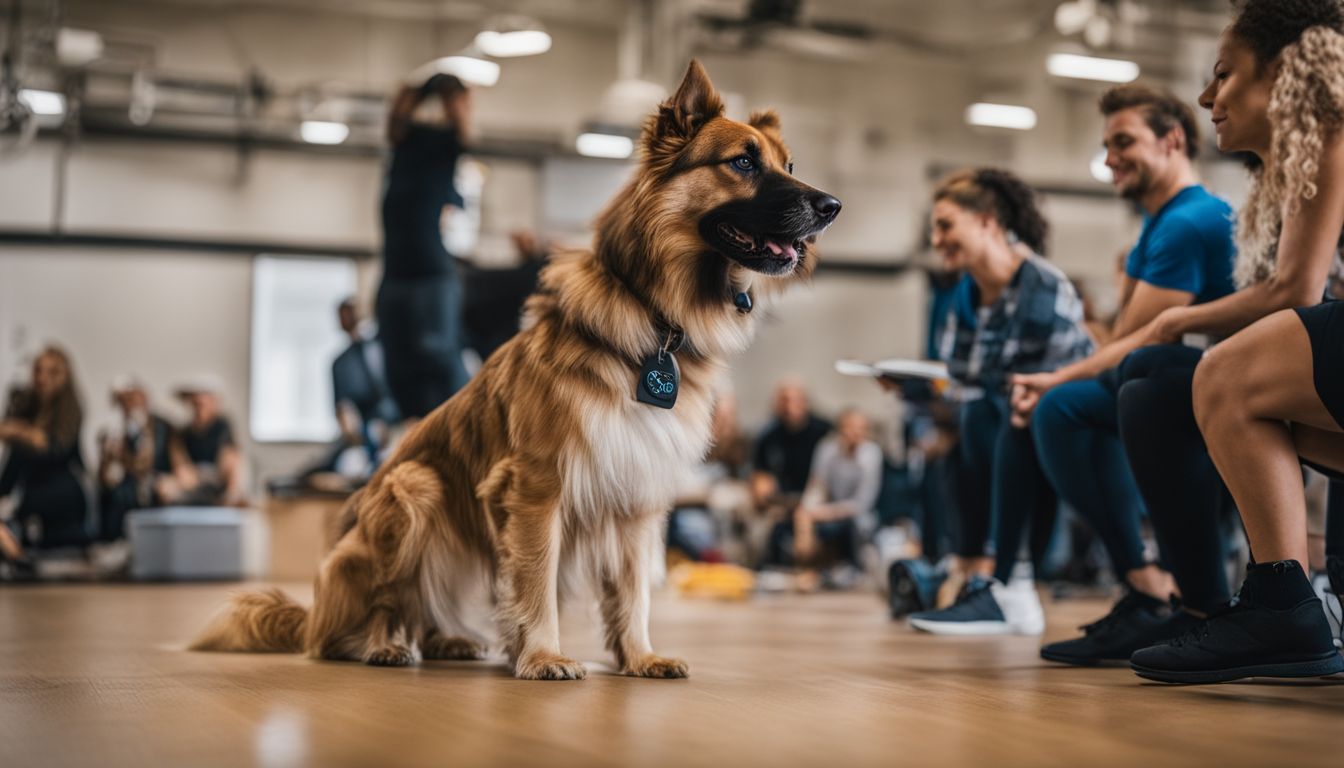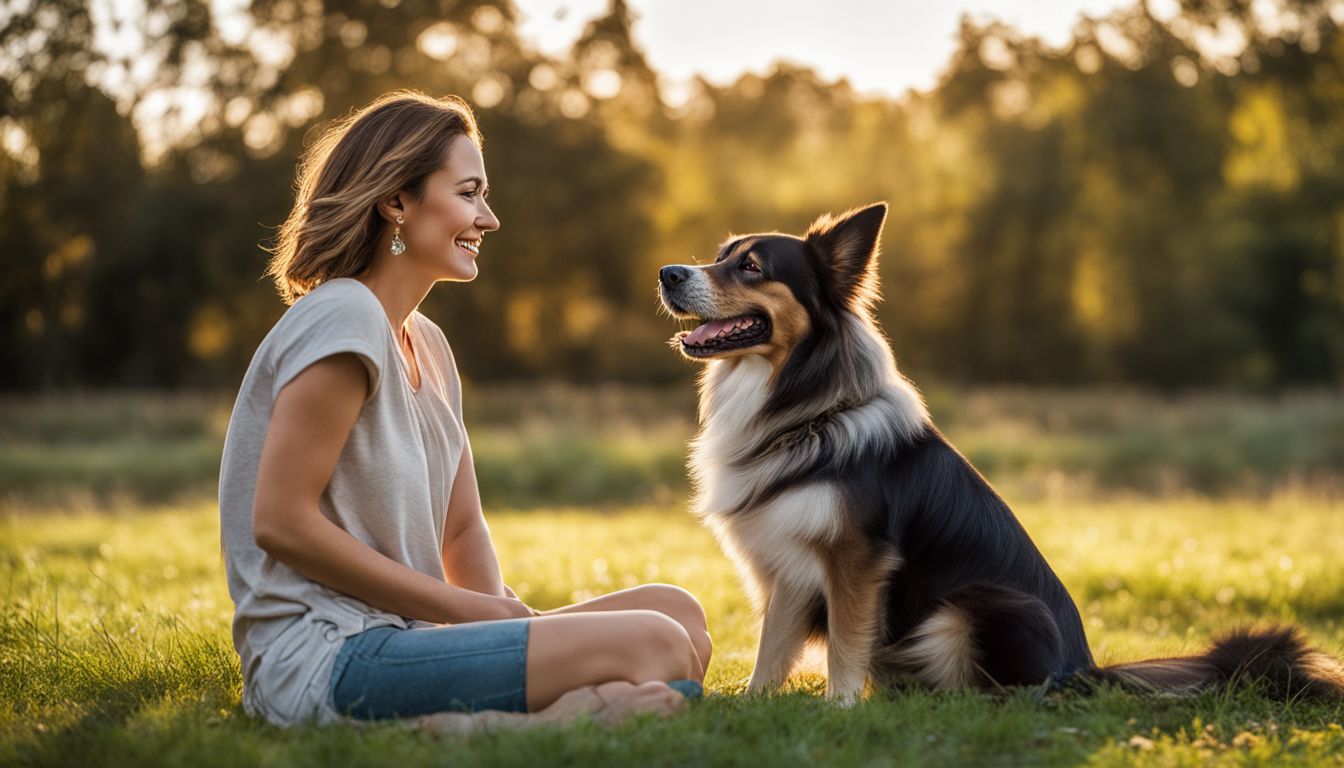Mastering Basic Dog Training Commands: Tips For Pet Owners
Are you struggling to get your dog to listen? You’re not alone. Teaching your fur baby the basic dog commands is key to improving their obedience. This article will guide you through mastering commands like sit, stay, and come, using positive reinforcement and other pet-parenting tips.
Start reading for a happier life with your pup.
The Importance of Basic Dog Training Commands

Training your dog with basic commands is key to a happy and safe pet life. Commands like sit, come, stay, and down are building blocks for any further obedience training. They help you lead as the pack’s alpha.
This leadership lets your pup understand what you expect from them. Simple commands also enhance safety by ensuring they listen and react in potentially dangerous situations.
Teaching these basics forms a strong bond between you and your canine friend. It turns training into an enjoyable task rather than a chore. For instance, getting your dog to master the sit command before moving onto others makes learning more accessible for both of you.
Use rewards and praises to encourage them; this way, training becomes fun! Always consider their age and health so they don’t get too tired or hurt during sessions. With patience and consistency, basic dog training sets the stage for advanced tricks while keeping obedience at the core of your relationship.
Essential Dog Commands to Teach Your Dog

Teaching your dog some essential commands is crucial for effective communication. It’s vital to establish clear expectations and boundaries with your canine companion.
Sit
Mastering the “sit” command is a key part of puppy training. It’s the first step in teaching your dog obedience and ensuring they follow basic commands for dogs. To teach “sit,” hold a treat close to your dog’s nose.
Move your hand up, allowing their head to follow the treat and causing their bottom to lower. Once they’re sitting, say “sit,” give them the treat, and share some affection. This method uses positive reinforcement, making learning enjoyable for both you and your dog.
Consistency is crucial with this technique. Practice “sit” several times a day but keep sessions short to avoid tiring them out – pups have limited focus and energy! Use a collar and leash during practice in safe areas which can help manage their movements.
As pet owners establish themselves as leaders using simple orders like “sit”, dogs learn expected behavior early on, helping build a foundation for more advanced dog tricks later.
Watch Me
Teaching your dog the “Watch Me” command is a key step in training. This command asks your dog to focus on you. It’s simple but powerful, helping to grab your pet’s attention in various situations.
Start by holding a treat near your face and using the command “Watch Me”. When your dog looks at you, give them the treat and praise them. It helps build concentration and prepares them for more complex commands.
Next, practice this skill in different places with more distractions around. As your dog gets better at focusing on you, it will make learning other commands like “Down” easier. This is because they understand to pay attention to you first before anything else.
Dog trainers often use this technique as part of competition obedience training or when working with rescue dogs to improve their focus and responsiveness.
Down
Training your dog to obey the “down” command is key. You guide your pet to lie down on its belly. This larger act of submission helps build a strong bond between you and your dog. It shows that you’re in charge but in a kind way.
The “down” position is also a building block for other training tasks. It can keep your dog calm and safe when needed.
After mastering “down,” move on to teaching your dog to stay put.
Stay
Teaching your dog to “stay” is like giving them a superpower for safety. This command stops them from running into dangerous spots, like busy streets. You tell your dog to sit first, then say “stay” with your hand flat in front of you.
Step back slowly. If they stand up or move, say “no” gently and try again. Once they stay still even when you’re a bit away, give them a treat and lots of praise.
This skill takes time and patience but pays off big time. It makes walks safer and helps your pooch become a well-behaved member of the family. For help mastering this and other basic commands, think about using resources from dog-training guides or consulting with professionals who understand the ins and outs of canine good citizen training without needing tools like choke chains that might hurt your pet.
Come
The “come” command is very important. It keeps your dog safe and helps you control them easily. You need to practice this command in a place with no distractions. Say “come” clearly and give your dog a reward when they do it right.
To make your dog learn faster, use treats or toys as rewards. This makes training fun for both of you. Practice often, but keep each session short to avoid tiring your dog. As they get better, try the command in different places with more distractions.
Heel
Heel teaches your dog to walk beside you, not pulling on the leash. This command makes walks safer and more enjoyable. First, have your dog sit at your side. Then, with a treat in hand, say “heel” and start walking.
If they stay by your side, give them the treat as a reward. Practice this in short sessions to keep their attention.
Next up is teaching your dog how to use positive reinforcement during training for better obedience.
Tips for Effective Training
Train your dog using positive reinforcement, consistency, and short sessions. Learn more about effective methods for training your dog on our blog!
Use positive reinforcement
Utilise rewards like treats and praise when training your dog. This encourages good behaviour and motivates them to learn. Positive reinforcement strengthens the bond between you and your pet, making training enjoyable for both of you.
It’s a proven method that helps dogs understand what actions please their owners.
Implementing positive reinforcement in your dog’s training creates a harmonious relationship, leading to faster progress and better results overall. By consistently rewarding desired behaviours, your furry friend will quickly grasp basic commands such as sit, come, and stay while developing respect for you as their leader.
This approach also fosters a trusting environment where your pet feels safe to explore new skills.
Be consistent
Consistency is key when training your dog. Stick to a regular schedule and use the same commands each time. This helps your dog understand what is expected of them and reinforces learning.
By being consistent, you build trust with your pet and create a stable environment for effective training.
Consistent communication and positive reinforcement are vital in shaping your dog’s behavior. Using the same cues consistently helps your furry friend understand what you expect from them, making it easier for them to learn and obey.
Being consistent in your approach sets clear boundaries for your dog, leading to successful training outcomes that strengthen the bond between you and your pet.
Start early
Commence dog training when your pup is young. Keep sessions short and in a familiar setting, ideally lasting five to ten minutes. Beginning early sets the groundwork for successful training and helps avoid issues later on.
The importance of starting basic command training early cannot be overstated. By starting early, you establish good behavior patterns from the outset and set your pup up for advanced training success.
Keep training sessions short
Start with brief, five to ten-minute training sessions in a familiar setting. Master the ‘sit’ command first before advancing to other instructions. Beginning with short sessions helps prevent over-tiring your pup and keeps them engaged.
It’s vital to consider your puppy’s age and physical capabilities while avoiding lengthy training sessions. These brief yet regular interactions can help solidify learning and maintain your dog’s interest in training.
Using positive reinforcement during these short sessions can also greatly enhance the effectiveness of the training process, ensuring that it remains an enjoyable experience for both you and your furry friend.
Consult a professional if needed
If you encounter challenges in training your dog or feel unsure about the process, consider seeking guidance from a certified dog trainer. They can provide tailored strategies and valuable insights to address specific behavioural issues or enhance your training techniques.
Additionally, consulting a veterinarian is advisable, especially when dealing with puppies. Vets offer expert advice on vaccinations, puppy care, and addressing any health concerns that may affect training.
Engaging professionals such as trainers and vets can greatly benefit both you and your furry companion’s overall training experience.
By considering assistance from reputable entities like certified dog trainers and veterinarians, pet owners can ensure that their dogs receive suitable guidance for effective training approaches while addressing any health-related considerations along the way.
This proactive approach aids in establishing strong foundational skills for your pet’s development and well-being.
Advanced Commands and Tricks
Take your dog’s training to the next level with a range of advanced commands and tricks. For more in-depth knowledge, read on.
Shake
Teaching your dog to shake is a fun trick that strengthens the bond between you and your pet. Begin by giving the command “shake,” then gently lift their paw with your hand. As they start to understand, use positive reinforcement like treats and praise.
Repeat this process until they can offer their paw on command without help. This trick adds flair to your dog’s abilities while reinforcing obedience and trust.
Additionally, our structured training programs encompass essential commands like “sit” and “stay”, laying a solid foundation for advanced tricks such as shaking paws, roll-overs, or playing dead – all helping create a more obedient and engaging companion for affiliate marketing in the realm of regenerative medicine!
Roll over
To teach your dog ‘roll over’, start by commanding “down”. Next, hold a treat close to their nose and slowly move it towards the shoulder. As they follow the treat, they will naturally roll onto their back.
Once they do, praise and reward them with the treat. Gradually add the command “roll over” as you perform this action until they associate it with flipping onto their back on cue.
Remember that every training session should be short and positive for effective learning. Consistency is crucial to reinforce this behavior in your dog.
By mastering these basic commands and adding more advanced ones like ‘roll over’ to your dog’s repertoire, you can build a strong bond with your pet and ensure both of you enjoy the training process while reaping its benefits.
Speak
Teaching your dog to ‘speak’ on command can be a fun and engaging activity. It’s a good way to strengthen the bond with your pet and enhance communication. When training this command, use positive reinforcement like treats and praise to encourage barking on cue.
Remember that consistency is key when teaching ‘speak’, so practice regularly in short sessions.
Ready for some advanced tricks? Let’s delve into teaching your pup how to “play dead”!
Play dead
Teach your dog the “play dead” command in a safe and comfortable environment. Use positive reinforcement to encourage them to lie down on their side, then reward them when they stay in that position for a few seconds.
You can gradually increase the duration as they get accustomed to it and always remember to keep training sessions short and enjoyable for both you and your furry friend.
Moving ahead with Advanced Commands – “Shake”.
Fetch
Teach your dog to fetch by using a toy or ball. Start with short training sessions and positive reinforcement. Encourage your pup to pick up the item and bring it back to you. This command can be an enjoyable way to bond with your pet and provide mental stimulation.
Remember, keep the practice fun for your furry friend, ensuring they associate fetching with a positive experience.
Conclusion.
Mastering basic dog training commands is essential for every pet owner. By teaching your dog commands like sit, come, stay, and down, you establish a strong foundation for effective communication.
Remember to keep training sessions short and use positive reinforcement to ensure successful learning. Consulting a professional can also provide invaluable guidance towards achieving the best results in training your furry friend.
With these tips in mind, you’ll be well on your way to having a well-behaved and obedient companion by your side.
FAQs
1. What is the first command I should teach my dog?
Start with “sit” as it is the easiest command for dogs to learn.
2. How long does it take to train a dog basic commands?
It usually takes a few weeks of consistent training to teach a dog basic commands.
3. Can old dogs learn new commands?
Yes, old dogs can learn new commands with patience and consistency.
4. Should I use treats when training my dog?
Using treats as rewards makes training more effective for most dogs.
5. What do I do if my dog doesn’t listen to my commands?
If your dog isn’t listening, try practicing in a quieter environment without distractions and be more consistent with your training sessions.

